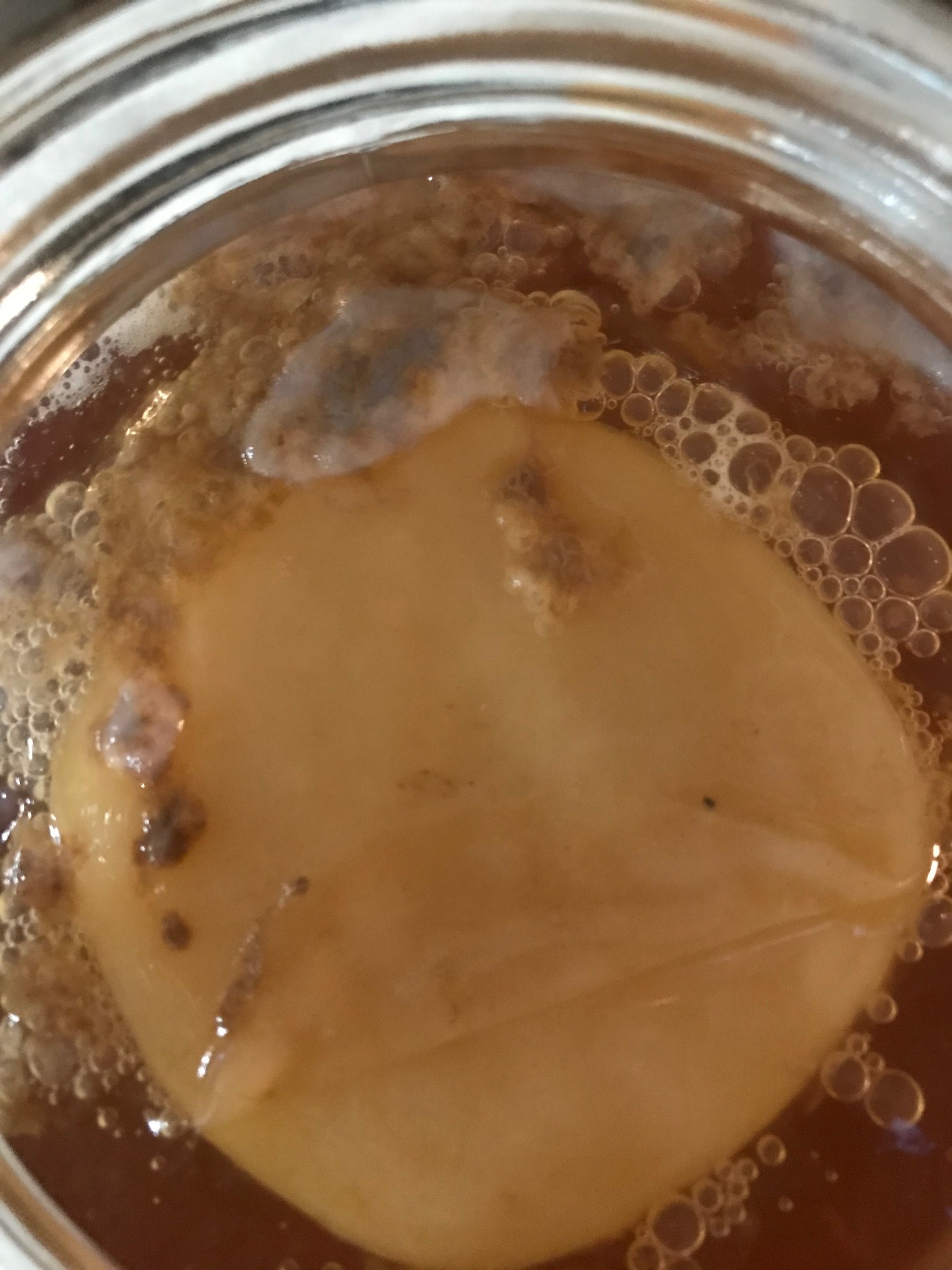Mold / Not Mold — UPDATED!
Every beginner home-brewer of kombucha has been there: Checking up on your scoby, seeing some unusual-looking film, or spots or bubbles, and wondering: Is it MOLD?! 😨 Is it not mold?
We'd love to reassure you that it's usually not mold. To demonstrate, we've selected a few photos that were sent to us by actual home brewers, inquiring about the health of their SCOBYs. In cases of mold, the scoby is no longer usable and must be discarded immediately.
We recommend the following home-brewing essentials to help keep your brews mold-free: A Ph reader, which helps you determine if you’re brew is healthy (3.5 Ph is ideal); high-quality tea, and of course a healthy SCOBY, starter and brewing vessel!
And now, onto our SCOBY gallery. Let’s figure out which ones are molded and which are totally fine. If you still have concerns, about your SCOBY, you can purchase our SCOBY Health + Care Course . We will respond within 24 hours, and tell you whether or not your SCOBY molded, and give you a more in-depth analysis and and tips on how to avoid mold next time.
Exhibit 1
White-ish film? Check.
Strange-looking tiny bubbles? There they are.
Brownish color throughout?
Scroll to find out what all this stuff could mean...
It means only one thing: Your scoby is working hard! It's absolutely, positively not mold. Bubbling, a white-ish looking film, some discoloration are all completely normal when the scoby starts doing her thing during first ferment.
Exhibit 2
What are these strange white warts on the scoby? Why are they scattered about the surface in this funny formation? Shouldn't the scoby be totally SMOOTH?
It can be, of course. So, what's happening here? Scroll down to find out...
What's happening here is a big ol' slice of normal! Your scoby is fine! That's not mold. That's just yeast and bacteria doing their happy dance. And sometimes, yes, it looks a little different than what you'd expect. Sometimes, the surface of the baby scoby may look a little rough, uneven. And that's OK! Because your scoby is not a contestant in a beauty pageant. She's just here to ferment your tea! And that's exactly what she's doing in the photo above.
Exhibit 3
Uh-oh, this can't be good. What are those greenish dots all over? Are they just weird bubbles?
If your scoby looks like this, then you, dear brewer, have a case of the dreaded mold. Icky, yucky mold. Yes, it sucks. Yes, you will lose your scoby. But take it as a lesson learned: Never expose your vessel or scoby to contaminants; always handle your scoby with clean hands, or wear gloves; be sure to keep your vessel in an environment where the temperature stays as close to the mid-70s degrees as possible, and balance all of the ingredients carefully: 1 cup of starter per 1 gallon of sweet tea.
Exhibit 4
If your scoby looks like this and you’re wondering if it has mold, then your only issue is self-doubt. You have nothing to worry about! A white thing sitting at the top your brew = NOT mold. Now go get busy making a killer batch of booch.
Exhibit 5
Every scoby is different, and no scoby forms exactly the same. Some may form perfectly uniformly; others, may take a little extra time to fuse into a whole. Like the one in this pic. If your scoby looks like this, then all you need to do is be patient, because that’s NOT mold!
Exhibit 6
If this is what you’re seeing when you peer down into your kombucha vessel, then we offer you our sincerest condolences, and suggest you make immediate funeral arrangements for your scoby. Because that is MOLD, dear friend.
Turns out, this brewer used a cloth that wasn’t woven tightly enough and allowed contaminants to pass through. Remember: Say no to cheesecloths! The weave must be tight enough to not let a speck of dust or a tiny fruit fly in. Yet it must also allow your scoby to breathe. Like our adorable cotton cloth covers!
Exhibit 7
What in the scoby mother is going on here? Nothing good, unfortunately. There are two moldy spots on this scoby: One in the top right corner, and another somewhat closer to the lower middle part of it. If it’s got a greenish/blue hue and a fuzzy appearance, it’s unmistakably mold.
In the case of this scoby, the brewer did not balance the starter/tea ratio well. Remember: The starter acts like a preservative for the tea, so if you don’t add enough, your scoby will mold. The ratio we always recommend is: 1 cup of starter (8oz) per 1 gallon of sweet tea (128 oz). It’s better to add more starter than less.
Exhibit 8
Bubbles, discoloration, globs of brown goo are all signs of a healthy, growing scoby! So if your scoby looks like this, rejoice: This is definitely NOT mold!
Exhibit 9
Ewww, what are those greenish globs stuck to the scoby? Look, we never said the process of fermenting is a pretty one. Stuff like this can happen, and it may not look pretty, but it’s all perfectly normal and is definitely NOT mold.
Those globs are just yeast, and sometimes they can appear greenish, when in fact they are brown. If you can tell, those globs are actually right under the surface, not sitting on top of the scoby. And mold, unlike yeast, will never form in the form of a glob, but rather more of a flat object that sits right on top of your scoby.
Exhibit 10
Once again, we see a scoby with brownish globs floating throughout, and some may wonder if all is going well here. And the truth is that, while it’s not a “perfect-looking” scoby, it is perfectly fine! NOT mold!
Exhibit 11
Ruh-roh. Something doesn’t look right here. A school of flat dots sitting on top of your scoby can only mean one thing: MOLD! This brew sat in an enclosed area, and the scoby did not have access to enough oxygen. No oxygen for scoby = death for scoby. So don’t leave your jars in a kitchen cabinet on a tight shelves with the door closed. Your scobys need to breathe.
* You can email your SCOBY pics here. Due to the overwhelming number of emails we receive, we cannot guarantee a response to every SCOBY mold-related question. If you would like a guaranteed, fast response, please purchase our quick SCOBY email consultation. We will tell you whether or not your SCOBY molded, and give you a more in-depth analysis and and tips on how to avoid mold next time.
By emailing us your moldy/no moldy SCOBY, you consent to having your email added to our newsletter mailing list.
Originally published on January 4, 2017. Updated on May 6, 2019. Images submitted by actual home-brewers.











